Ma Yi Shang Shu, or stir fried vermicelli with pork, is a perfect quick weekday dinner dish that is so flavorful yet easy to put together. A Sichuan classic, it features tender mung bean vermicelli noodles braised in a savory aromatic sauce with ground pork, spiced up with chili bean paste. All you need is 20 minutes to put it together – top it on a bowl of steamed rice for a great dinner! {Gluten-Free Adaptable}
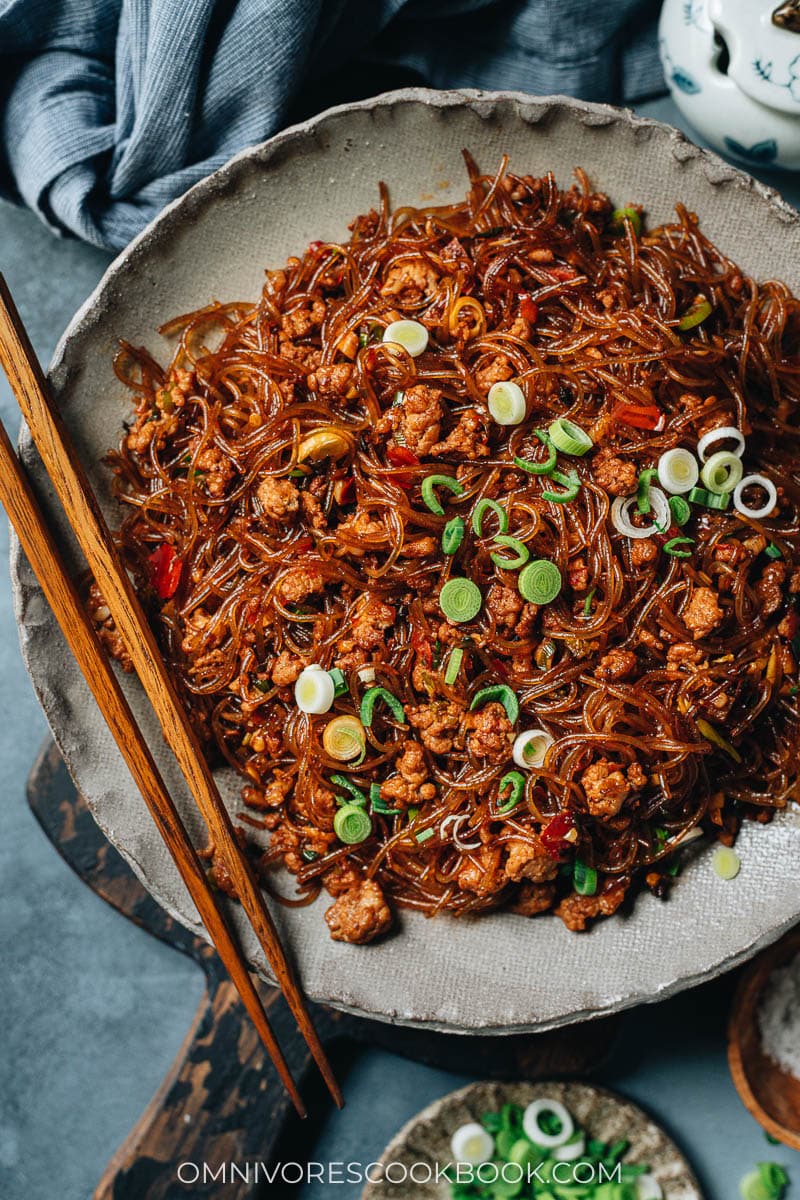
Some Chinese dishes have the weirdest names. Such as Husband and Wife Lung Slices (Fu Qi Fei Pian), Saliva Chicken (Chicken in Red Oil), and this one – translated literally it means Ants Climbing a Tree. Sometimes Chinese restaurants need to be creative and give a dish an interesting name to lure their guests in. For example, using the name “Husband and Wife’s Special” instead of lung pieces. And once you get past the sound of the name and try out the dish, you’ll often find them super delicious.
What is Ma Yi Shang Shu
Ma Yi Shang Shu (蚂蚁上树), or Ants Climb a Tree, is famous Sichuan dish. Rest assured, it does not contain any ants. It is made with braised vermicelli noodles and ground pork in a slightly spicy and savory sauce, along with aromatics. When you serve the dish by pulling up the noodles with chopsticks, you will notice small bits of pork clinging to the noodles. And that’s where the name of the dish comes from – because it resembles ants climbing up a tree branch.
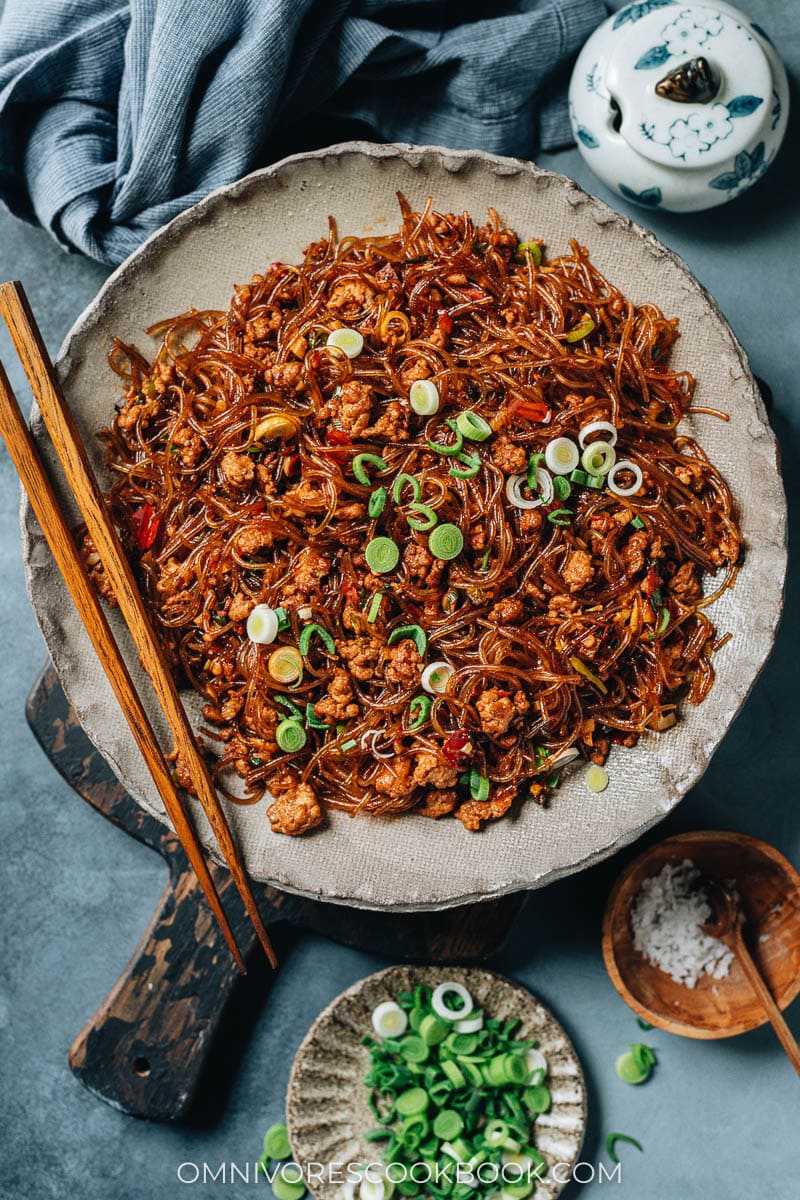
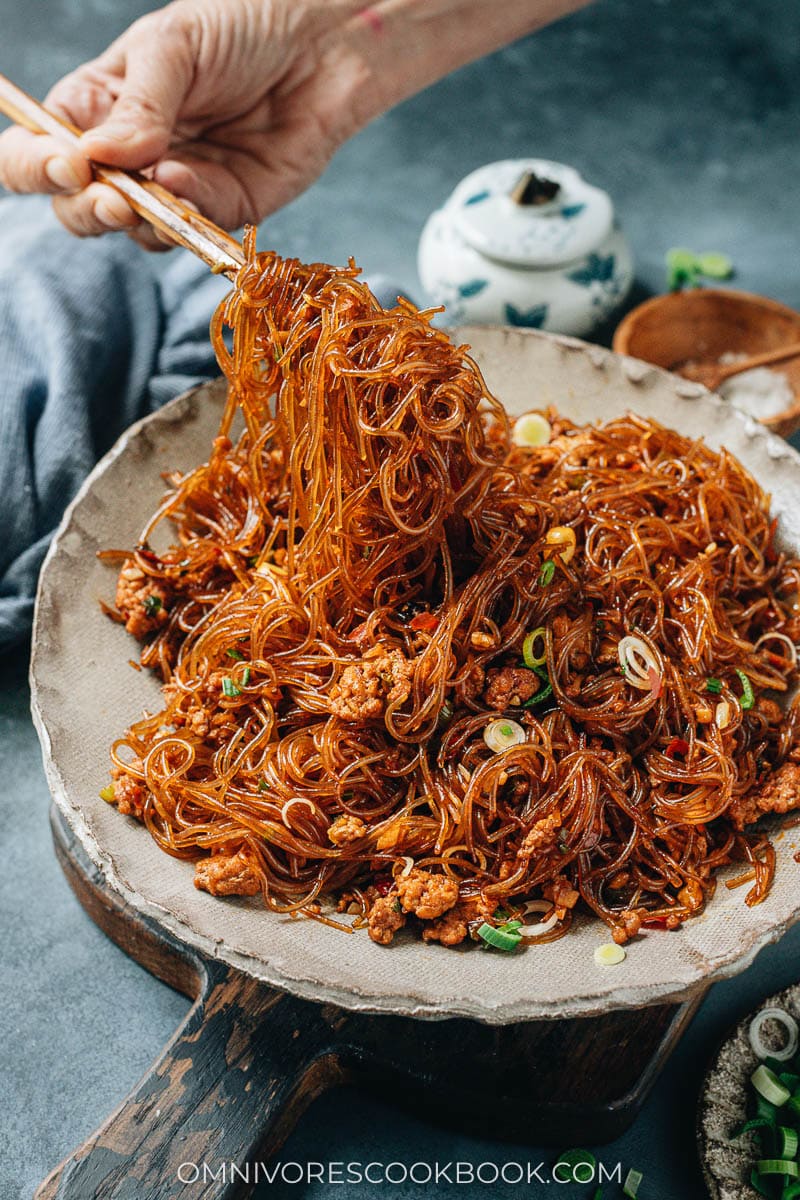
Ingredients
What type of vermicelli noodles to use
To create the most authentic experience, you should use mung bean vermicelli noodles for Ma Yi Shang Shu. Also called bean thread noodles or cellophane noodles, they are dried threads of white noodles. Once cooked, they will expand and become more transparent. Compared to rice vermicelli, they have a softer and smoother texture. Traditional Ma Yi Shang Shu usually uses thin thread noodles. But I’ve used the thicker type in the past and really liked the result. You can find the mung bean vermicelli at your local Asian market or on Amazon.
If you cannot find the mung bean type, sweet potato vermicelli noodles can be a great replacement.

Doubanjiang (Fermented Spicy Bean Paste)
Doubanjiang (豆瓣酱), also known as spicy fermented bean paste or broad bean sauce, is one of the most important ingredients in Sichuan cuisine. It has a strong fermented savory, salty and spicy taste. This recipe uses a very simple sauce. But with doubanjiang, everything immediately becomes super flavorful.
Try to find “Pixian Broad Bean Paste” at your Asian market. Pixian is a small county in Sichuan province that produces the best broad bean paste. If you’re using this brand, you’re already halfway there. You can also purchase this brand on Amazon here.
Mise en place
When you’re ready to cook, your table should have:
- Mixed sauce
- Doubanjiang
- Chicken broth
- Chopped ginger, garlic and green onion
- Ground pork
- Soaked vermicelli noodles

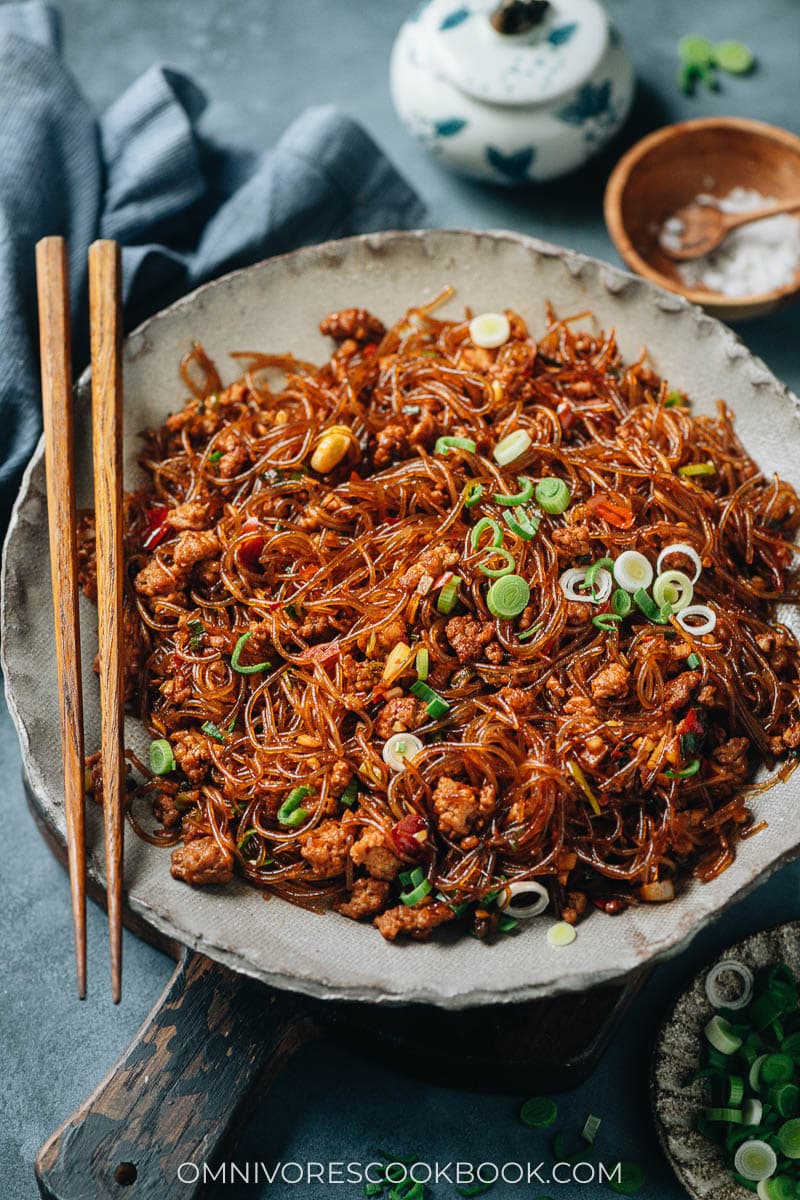
What pan to use
A large nonstick skillet is the best to make Ma Yi Shang Shu. Rehydrated vermicelli noodles are very starchy and can easily stick to the pan when they’re not floating in the broth. And for Ma Yi Shang Shu, the broth needs to be cooked down completely at the end for the best result. Use a nonstick skillet to prevent the noodles from sticking to the pan as you finish cooking.
In Chinese restaurants, this dish is usually cooked in a hot wok. At the end of the cooking, the chef would toss the noodles very quickly at high heat, to impart a heavenly smoky taste. This recipe does not use that technique because it’s challenging to do in a home kitchen setting. Plus, you will need to use much more oil (restaurants opt to use pork lard sometimes), so the noodles don’t stick to the wok. I think my home-style version tastes just as great, and it uses a lot less oil.
How to cook Ma Yi Shang Shu
Cooking Ma Yi Shang Shu couldn’t be easier. All you need is:
- Gently saute the aromatics
- Cook the pork
- Mix in the doubanjiang
- Add the broth and noodles and the sauce
- Cover to steam the noodles
- Uncover and finish up by boiling down the broth
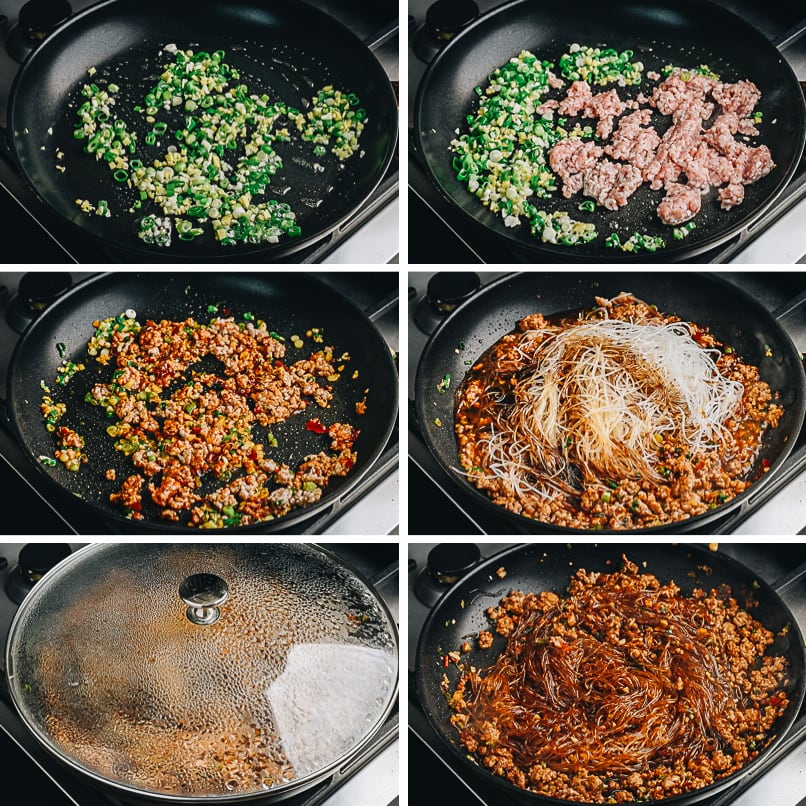
Once done, the noodles will soak up the super flavorful broth that is infused with heavenly flavors from the aromatics and the pork. You can enjoy the dish by itself but it also goes great with steamed rice.
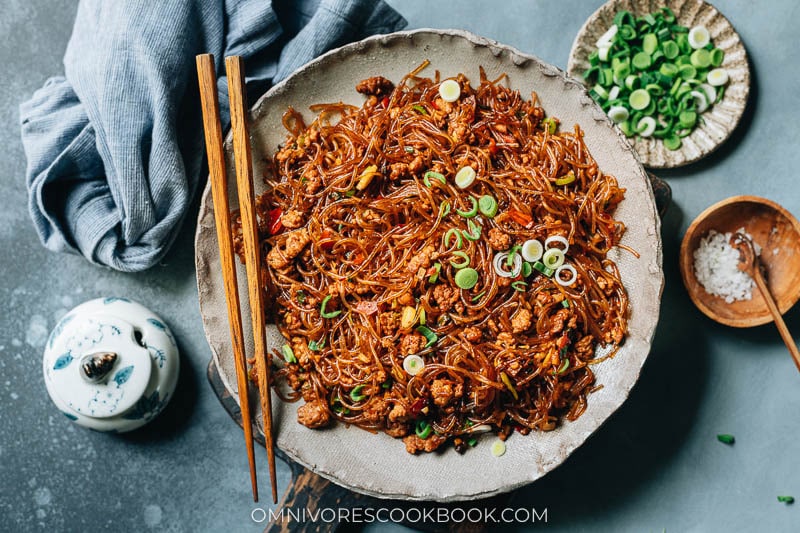
Other quick dinner ideas
- Dry Pot Cauliflower (干锅菜花)
- Authentic Mapo Tofu (麻婆豆腐)
- Chinese Bang Bang Chicken (棒棒鸡)
- Pork Lettuce Wrap (San Choy Bow)
- Suan La Fen (Hot and Sour Noodle Soup, 酸辣粉)
- 15-Minute Pork Fried Rice
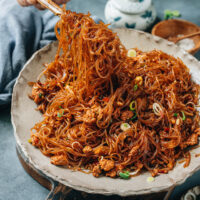
Stir Fried Vermicelli with Pork (Ma Yi Shang Shu, 蚂蚁上树)
Ingredients
- 4 oz. (110 g) dried mung bean vermicelli noodles
- 1 tablespoons peanut oil (or vegetable oil) (*Footnote 1)
- 1 tablespoon minced ginger
- 2 cloves garlic , minced
- 2 green onions , sliced
- 1 tablespoon doubanjiang
- 4 oz. (120 g) ground pork
- 1/2 cup chicken broth (or water)
Sauce
- 1 tablespoon light soy sauce
- 1 teaspoon dark soy sauce
- 1 tablespoon Shaoxing wine (or dry sherry)
- 1 teaspoon sugar
Instructions
- Place the vermicelli noodles in a big bowl and add hot water to cover. Soak according to the package instructions. If the package does not have instructions, soak the noodles in hot water for 15 minutes. Once done, drain thoroughly, toss with 1/2 tablespoon oil, and set aside.
- Mix the sauce ingredients in a small bowl and set aside.
- Heat 1/2 tablespoon oil in a nonstick pan over medium heat until hot. Add the ginger, garlic and green onion. Cook and stir for 30 seconds to release fragrance.
- Add the ground pork. Cook and chop the pork into smaller pieces, until the pork is fully cooked, 2 minutes or so.
- Add the doubanjiang. Cook and stir for 1 minute, until the pork is covered evenly.
- Pour in the chicken broth, the soaked vermicelli noodles, and the sauce. Stir a few times to mix well. Cover and cook for 2 to 3 minutes. Uncover the pan. Stir to mix well and check the doneness of the noodles. If the noodles are still tough, cover it and cook for another minute or so. Once the noodles have turned soft, cook uncovered over medium-high heat until the liquid evaporates, about 1 minute. Once done, transfer everything to a plate. Serve hot as a main dish.
Notes
- Use 1/2 teaspoon toasted sesame oil at the end (step 6, after uncovering the pan) if you use vegetable oil instead of peanut oil.













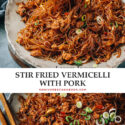
What’s a quick veggie dish to make with this, for someone who cannot multitask?
I think the cucumber salad is a great option: https://omnivorescookbook.com/recipes/easy-chinese-cucumber-salad
Or the super easy baby bok choy stir fry: https://omnivorescookbook.com/baby-bok-choy-stir-fry/
You will need to cook the bok choy afterwards, but if you already cut them, it takes like 5 minutes to cook.
Thanks Maggie!
The doubanjiang seem to give it a deep flavor without being too spicy. This was a great recipe. Thank you.